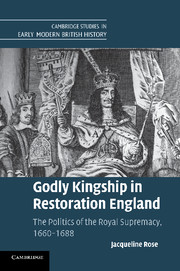Book contents
- Frontmatter
- Contents
- Acknowledgements
- Abbreviations and conventions
- Introduction The Restoration, the Reformation, and the royal supremacy
- Chapter 1 Foundations and legacies: the Reformation and the royal supremacies, 1530–1660
- Chapter 2 The crown and the cavalier Anglicans: prerogative, parliament, and ecclesiastical law
- Chapter 3 Spiritual authority and royal jurisdiction: the question of bishops
- Chapter 4 Dissenters and the supremacy: the question of toleration
- Chapter 5 Anticlericals and ‘Erastians’: the spectre of Hobbes
- Chapter 6 Catholics and Anglicans: James II and Catholic supremacy
- Conclusion
- Bibliography
- Index
Chapter 2 - The crown and the cavalier Anglicans: prerogative, parliament, and ecclesiastical law
Published online by Cambridge University Press: 05 July 2011
- Frontmatter
- Contents
- Acknowledgements
- Abbreviations and conventions
- Introduction The Restoration, the Reformation, and the royal supremacy
- Chapter 1 Foundations and legacies: the Reformation and the royal supremacies, 1530–1660
- Chapter 2 The crown and the cavalier Anglicans: prerogative, parliament, and ecclesiastical law
- Chapter 3 Spiritual authority and royal jurisdiction: the question of bishops
- Chapter 4 Dissenters and the supremacy: the question of toleration
- Chapter 5 Anticlericals and ‘Erastians’: the spectre of Hobbes
- Chapter 6 Catholics and Anglicans: James II and Catholic supremacy
- Conclusion
- Bibliography
- Index
Summary
The Civil Wars and Interregnum did not change the English polity into a constitutional monarchy. The Restoration Settlement restored both the powers and the problems which had existed in 1641. Only the memory of ‘the world turned upside down’ and Charles II’s politicking prevented renewed breakdown for some years. It was not surprising that religion played a major role in these events, for it was a historic flashpoint between crown and parliament. As the previous chapter has shown, many Tudor and early Stuart MPs and common lawyers asserted that statute and common law as well as royal prerogative governed the church, canons, and convocation. Such claims often derived from men who sought further reformation and in the 1640s they had their way.
- Type
- Chapter
- Information
- Godly Kingship in Restoration EnglandThe Politics of The Royal Supremacy, 1660–1688, pp. 89 - 128Publisher: Cambridge University PressPrint publication year: 2011

